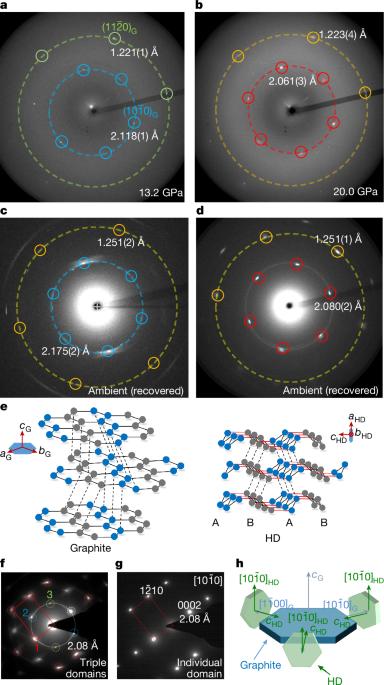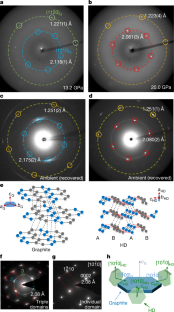Synthesis of bulk hexagonal diamond
IF 48.5
1区 综合性期刊
Q1 MULTIDISCIPLINARY SCIENCES
引用次数: 0
Abstract
Hexagonal diamond (HD), with anticipated physical properties superior than the known cubic diamond, has been pursued relentlessly since its inception 60 years ago1. However, natural and synthetic HD has only been preserved as a highly disordered component in fragile, heterogeneous mixtures of other nanocarbon structures that precludes determination of bulk properties and identification of HD as a bona fide crystalline phase2–4. Here we report the synthesis, recovery and extensive characterization of bulk HD by compressing and heating high-quality graphite single crystals under controlled quasi-hydrostatic conditions. We demonstrate the successful synthesis of 100-µm-sized to mm-sized, highly ordered, bulk HD. We observed direct transformation of graphite ( $$10\bar{1}0$$ ) orientation to HD (0002) and graphite (0002) to HD ( $$10\bar{1}0$$ ). The bulk sample consists of threefold intergrowth of tightly knitted 100-nm-sized crystals, predominantly HD with trace imperfections of cubic diamond. The interlayer bonds in HD are shortened with respect to intralayer bonds to optimize the HD structure. Notably, the hardness of HD is only slightly higher than cubic diamond. We anticipate that purifying the precursor graphite carbon and fine-tuning the high pressure–temperature (P–T) synthesis conditions may lead to higher-quality HDs. The synthesis, recovery and detailed characterization of bulk hexagonal diamond under high pressure and temperature conditions using precursor graphite carbon is described, demonstrating the first successful synthesis in the 100 µm to millimetre size range.


块状六方金刚石的合成
六方金刚石(HD)具有比已知的立方金刚石更优越的物理性能,自60年前问世以来,人们一直孜孜不倦地追求它。然而,天然和合成的HD只作为一种高度无序的成分保存在其他纳米碳结构的易碎的非均质混合物中,这就排除了对HD整体性质的测定和作为真正结晶相的鉴定2,3,4。本文报道了在受控的准流体静力条件下,通过压缩和加热高质量石墨单晶,合成、回收和广泛表征大块HD。我们成功地合成了100微米到mm大小、高度有序的块状HD。我们观察到石墨(\(10\bar{1}0\))取向直接转变为HD(0002)和石墨(0002)取向直接转变为HD (\(10\bar{1}0\))。大块样品由三层紧密编织的100纳米大小的晶体组成,主要是HD,带有微量的立方金刚石缺陷。相对于层内键,HD中的层间键被缩短,以优化HD的结构。值得注意的是,HD的硬度仅略高于立方金刚石。我们期望通过对前驱体石墨碳的提纯和对高压-高温合成条件的微调,可以获得更高质量的hd。
本文章由计算机程序翻译,如有差异,请以英文原文为准。
求助全文
约1分钟内获得全文
求助全文
来源期刊

Nature
综合性期刊-综合性期刊
CiteScore
90.00
自引率
1.20%
发文量
3652
审稿时长
3 months
期刊介绍:
Nature is a prestigious international journal that publishes peer-reviewed research in various scientific and technological fields. The selection of articles is based on criteria such as originality, importance, interdisciplinary relevance, timeliness, accessibility, elegance, and surprising conclusions. In addition to showcasing significant scientific advances, Nature delivers rapid, authoritative, insightful news, and interpretation of current and upcoming trends impacting science, scientists, and the broader public. The journal serves a dual purpose: firstly, to promptly share noteworthy scientific advances and foster discussions among scientists, and secondly, to ensure the swift dissemination of scientific results globally, emphasizing their significance for knowledge, culture, and daily life.
 求助内容:
求助内容: 应助结果提醒方式:
应助结果提醒方式:


